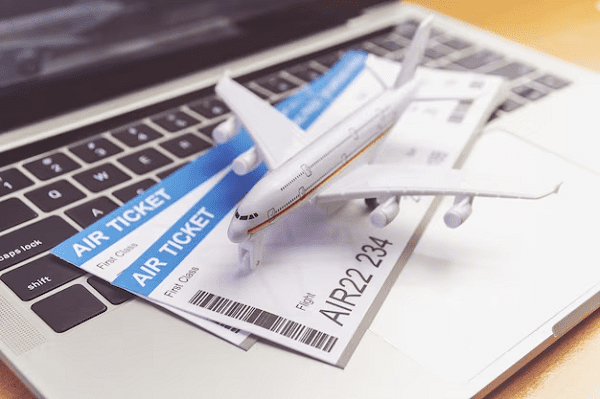Airline rate- Airline rates, also known as airfare or ticket prices, can vary widely depending on several factors. These factors include:
- Destination: The cost of a flight can vary based on the distance you are traveling and the specific airport you are flying to.
- Season: Traveling during peak seasons, such as holidays or summer vacation, tends to be more expensive than traveling during off-peak times.
- Booking Time: The timing of your booking can affect the price. Booking well in advance or being flexible with your travel dates can sometimes help you find lower fares.
- Airline and Class: Different airlines have varying pricing strategies, and the class of service you choose (economy, business, first class) will impact the cost of your ticket.
- Route and Layovers: The number of stops and layovers on your route can also affect the price. Non-stop flights are often more expensive than those with layovers.
- Seat Availability: The availability of seats on a particular flight can influence the price. Prices can increase as the available seats on a flight fill up.
- Demand: If a particular flight is in high demand, the prices may be higher, especially if there is limited competition on that route.
- Promotions and Discounts: Airlines often run promotions, discounts, and sales that can significantly reduce the cost of your ticket.
- Loyalty Programs and Miles: Frequent flyers can use loyalty programs and miles to get discounts or free flights.
- Market Conditions: External factors such as fuel prices, economic conditions, and global events can also impact airline ticket prices.
To find the best airline rate for your specific travel plans, it’s recommended to use online flight search engines and booking platforms, compare prices, and consider factors like the ones listed above. Additionally, signing up for fare alerts and being flexible with your travel dates can help you secure the most favorable rates.
What is Airline rate
“Airline rate” typically refers to the cost or price of an airline ticket for a particular flight. It’s the amount of money a passenger needs to pay to book a seat on an airplane to travel from one location to another. Airline rates can vary widely depending on factors like the destination, the airline, the class of service (economy, business, first class), the time of booking, the time of travel, seat availability, and various other factors.
Airline rates are essentially the fares that passengers pay to use the services provided by commercial airlines. These rates can fluctuate based on supply and demand, seasonal variations, route popularity, and the airline’s pricing strategies. To find the best airline rate for your travel needs, you can use various online travel booking websites and tools that allow you to compare fares from different airlines and make informed decisions about your flight options.
Who is Required Airline rate
It seems like you might be asking about a specific airline or a requirement related to airline rates, but the question is too vague for me to provide a specific answer.
If you have a question about a particular airline or need information related to airline rates for a specific purpose, please provide more context or clarify your question, and I’ll do my best to assist you.
When is Required Airline rate

Airline rates, or the prices of airline tickets, can vary depending on various factors, but they are typically determined by the airlines and can change frequently. There is no specific time or date when airline rates are fixed. Several factors can influence the price of airline tickets, including:
- Demand: Airline rates can be higher during peak travel seasons, holidays, and popular events when more people are flying to a particular destination.
- Supply: The availability of seats on a flight can affect prices. As seats fill up on a plane, the remaining seats may become more expensive.
- Time of Booking: Booking well in advance or being flexible with your travel dates can sometimes help you find lower fares. Last-minute bookings may have higher prices.
- Airline and Class: Different airlines have different pricing strategies, and the class of service you choose (economy, business, first class) will impact the cost of your ticket.
- Promotions and Discounts: Airlines often run promotions, discounts, and sales that can reduce the cost of your ticket.
- Market Conditions: External factors such as fuel prices, economic conditions, and global events can also impact airline ticket prices.
To find the most favorable airline rate for your specific travel plans, it’s recommended to use online flight search engines and booking platforms to compare prices and consider the factors listed above. Airlines frequently adjust their prices, so it’s a good idea to monitor fares and be flexible with your travel plans if possible to secure the best rates.
Where is Required Airline rate
Airline rates, or the prices of airline tickets, are not tied to a specific location; they can be found and booked through various means and platforms. You can typically find airline rates in the following places:
- Online Travel Booking Websites: Popular travel websites and platforms like Expedia, Kayak, Google Flights, Orbitz, and others allow you to search for and book airline tickets.
- Airline Websites: Most airlines have their own websites where you can search for rates, book flights, and access special offers and discounts.
- Travel Agencies: Traditional travel agencies and online travel agencies can help you find and book airline tickets.
- Mobile Apps: Many airlines and travel booking platforms have mobile apps that you can use to search for and book flights.
- Through Airlines Directly: You can contact airlines’ customer service or visit their ticketing offices, if applicable, to inquire about and book airline rates.
To find the specific airline rate you’re looking for, you’ll need to specify your travel details, including your departure and destination airports, travel dates, and any other preferences. This will allow you to receive accurate pricing information for your chosen itinerary.
How is Required Airline rate
To find airline rates and book a flight, you can follow these steps:
- Online Search: Use a search engine or a travel booking website such as Expedia, Kayak, Google Flights, Skyscanner, or Orbitz. On the website’s homepage, enter your departure and destination airports, travel dates, and the number of passengers. Click on the “Search” or “Find Flights” button.
- Browse the Results: After entering your travel details, you’ll be presented with a list of available flights for your chosen route. These results will include different airline rates.
- Filter and Compare: You can often filter and sort the results by factors such as price, airline, flight duration, number of stops, and departure/arrival times. Use these filters to find the best options for your needs.
- Select Your Flight: Choose the flight that suits your preferences and budget. Click on the flight details to see more information about the airline rate, including baggage policies, seat selection options, and in-flight services.
- Book Your Flight: Once you’ve selected your preferred flight, you can proceed with the booking process. Enter the passenger information, payment details, and any additional services or preferences you may have.
- Review and Confirm: Before finalizing your booking, review all the details, including the total cost, flight itinerary, and passenger information. Make sure everything is accurate, and then confirm your booking.
- Payment: Pay for your ticket using your preferred payment method, such as credit card or other available options.
- Receive Confirmation: After completing the booking process, you will receive a confirmation email with your e-ticket or booking reference. Make sure to keep this confirmation for your records and for check-in at the airport.
Please note that airline rates can vary based on factors like the airline, the class of service, booking time, and demand, so it’s a good idea to compare multiple options before making your final decision. Additionally, be aware of any additional fees, such as baggage fees or seat selection fees, which may not be included in the initial rate.
Case Study on Airline rate
Title: “Factors Affecting Airline Rates: A Case Study of XYZ Airlines”
Background: XYZ Airlines is a regional airline operating domestic and international flights. They are facing the challenge of optimizing their pricing strategy to remain competitive and profitable in a highly dynamic and competitive market.
Objectives:
- To understand how various factors influence airline rates.
- To identify strategies that can be employed to maximize revenue while ensuring customer satisfaction.
Methodology: XYZ Airlines conducted a comprehensive analysis of their pricing strategies over a one-year period, considering various factors that impact airline rates.
Factors Analyzed:
- Demand: The airline analyzed the demand for different routes during peak and off-peak seasons, as well as the impact of holidays and special events.
- Competition: They assessed the pricing strategies of competitors on similar routes to gauge their competitiveness.
- Booking Window: The airline examined how booking times (early booking vs. last-minute booking) affected ticket prices.
- Seasonal Variation: They studied how rates fluctuated during peak travel seasons and off-peak periods.
Findings:
- Demand: XYZ Airlines found that ticket prices increased during peak travel seasons, with higher demand leading to higher rates. They also noticed that certain routes experienced more consistent demand throughout the year.
- Competition: The airline discovered that on routes with high competition, they often had to adjust rates to remain competitive. On less competitive routes, they had more flexibility in setting prices.
- Booking Window: Rates were generally lower for passengers booking well in advance, encouraging early bookings. However, last-minute bookings were sometimes priced higher, targeting business travelers and those with urgent needs.
- Seasonal Variation: During peak seasons, prices were higher, but XYZ Airlines offered promotions and discounts to attract travelers during off-peak periods.
Strategies Implemented:
- Dynamic Pricing: XYZ Airlines adopted dynamic pricing models that allowed them to adjust rates based on real-time demand and competitive factors.
- Loyalty Programs: They introduced a loyalty program to retain frequent flyers and provide discounts and perks to loyal customers.
- Promotions: The airline launched targeted promotions during off-peak seasons to stimulate demand and attract budget-conscious travelers.
- Market Segmentation: By segmenting their market and understanding customer preferences, they were able to tailor pricing strategies to different customer segments.
Results: XYZ Airlines successfully optimized their pricing strategy based on the above findings and strategies. They increased revenue during peak seasons while remaining competitive during less busy times. Their loyalty program gained popularity, and customer satisfaction improved.
Conclusion: This case study demonstrates that airline rates are influenced by a complex interplay of factors, and airlines need to continuously analyze and adjust their pricing strategies to remain competitive and profitable in the industry. Adapting to market conditions, understanding customer behavior, and offering targeted promotions are essential to success in the airline industry.
White paper on Airline rate
Abstract:
- Provide a concise summary of the main findings and recommendations of the white paper.
Table of Contents:
- Introduction:
- Provide an overview of the airline industry and the significance of airline rates.
- Factors Influencing Airline Rates:
- Discuss the various factors that impact airline ticket pricing, such as demand, competition, seasonality, booking time, and market conditions.
- Pricing Strategies:
- Describe common pricing strategies used by airlines, including dynamic pricing, fare classes, and yield management.
- Case Studies:
- Present real-world examples of how different airlines have adjusted their rates based on various factors and market conditions.
- Customer Behavior:
- Analyze how customer preferences and booking habits influence airline rates.
- Technology and Data Analysis:
- Discuss the role of technology and data analytics in optimizing airline pricing strategies.
- Regulations and Government Policies:
- Explain how government regulations and policies can impact airline rates and the industry as a whole.
- Recommendations:
- Provide practical recommendations for airlines to optimize their pricing strategies, enhance customer satisfaction, and remain competitive.
- Conclusion:
- Summarize the key takeaways from the white paper.
- References:
- Cite the sources and references used in the white paper.
Appendices (if necessary):
- Include additional information, data, or charts that support the findings and recommendations.
Glossary (if necessary):
- Define industry-specific terms and acronyms for the reader’s reference.
Remember that a white paper should be well-researched and provide valuable insights into the chosen topic. It should be written in a clear and informative style, with a focus on providing practical recommendations or solutions to the issues discussed. You may also want to include charts, graphs, and data to illustrate key points and trends in the airline industry related to rates.
Industrial Application of Airline rate
The concept of “airline rates” as applied to the airline industry is not typically associated with industrial applications. However, the airline industry itself can be seen as an industrial sector with numerous applications and implications. Here are a few industrial applications of airline operations and rates:
- Cargo Transportation: Airlines play a crucial role in the global supply chain by transporting goods and cargo. This industrial application involves the movement of raw materials, finished products, and time-sensitive materials, benefiting various industries, including manufacturing, pharmaceuticals, and e-commerce.
- Aerospace Manufacturing: The design, production, and maintenance of aircraft constitute a significant industrial sector. Aerospace manufacturing facilities produce commercial and military aircraft, engines, avionics, and other components.
- Airline Maintenance and Repair: The airline industry relies on extensive maintenance, repair, and overhaul (MRO) operations to ensure the safety and reliability of aircraft. This industrial application encompasses facilities and skilled personnel dedicated to servicing and repairing airplanes.
- Aviation Fuel Production: The production and distribution of aviation fuels, such as aviation gasoline (avgas) and jet fuel, are crucial industrial activities that support the airline industry.
- Airport Infrastructure: The construction and management of airport facilities, including runways, terminals, and control towers, is a vital part of the aviation sector. These facilities are significant infrastructure projects with wide-reaching industrial implications.
- Travel and Tourism: The airline industry is closely tied to the travel and tourism sector. This includes hospitality, travel agencies, and various service industries that cater to tourists and travelers.
- Aircraft Manufacturing Materials: Industrial applications include the production of materials and components used in aircraft manufacturing, such as lightweight metals, composites, and advanced alloys.
- Information Technology and Software Development: Developing airline reservation systems, flight management software, and aviation-related technologies are important industrial sectors that support airline operations.
- Aircraft Interiors: The design, production, and installation of aircraft interiors, including seats, entertainment systems, and cabin configurations, are integral to the airline industry.
- Aerospace Research and Development: Industrial applications encompass research and development activities aimed at enhancing aircraft performance, safety, and efficiency.
While “airline rates” primarily refer to the pricing of airline tickets, the broader airline industry has numerous industrial applications and interdependencies with various sectors, making it a significant contributor to the global economy. These applications span manufacturing, transportation, infrastructure development, and technology, among others.





